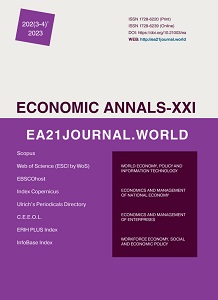An econometric analysis of price elasticity and demand factors in the global honey and honey-based beverage markets
An econometric analysis of price elasticity and demand factors in the global honey and honey-based beverage markets
Author(s): Tamara Tultabayeva, Umyt Zhumanova, Mukhtar Tultabayev, Aruzhan ShomanSubject(s): Economy, National Economy, Business Economy / Management, Financial Markets, Socio-Economic Research
Published by: Institute of Society Transformation
Keywords: Honey Market; Beverages; Kazakhstan; Econometrics; Price Elasticity of Demand; Longitudinal Data; Ordinary Least Squares (OLS); Co-integration; Error-Correction Models; Demand Determinants;
Summary/Abstract: The contemporary discourse on global commodity markets presents a myriad of compelling quandaries for scholars, policy-makers, and practitioners alike. Among these markets, since 2015 the global honey and honey-based beverage sector embodies unique economic characteristics and dynamics. While the market has experienced expansive growth in a plethora of jurisdictions, Kazakhstan remains out of focus of researchers. For this reason, we decided to undertake an exhaustive econometric analysis, scrutinizing the price elasticity of demand and various demand determinants in Kazakhstan’s honey and honey-based beverage markets. Utilizing longitudinal data spanning over a decade, this investigation employs advanced econometric methodologies - including but not restricted to Ordinary Least Squares (OLS) regressions, co-integration analyses, and error-correction models - to rigorously interrogate the price elasticity of demand for honey and honey-based beverages. The research encompasses multiple control variables like GDP per capita, consumer behavior, inflation rates, and population dynamics to create a multi-faceted econometric model capable of rendering nuanced insights. It incorporates both macroeconomic and microeconomic variables to delineate the symbiotic relationship between price elasticity and demand determinants such as consumer income, advertising impact, and price points of substitute and complementary goods. The analysis showed that the honey market in Kazakhstan is fundamentally oligopolistic, and the triumvirate of top producers collectively wield a 60% market control, leaving a residual 40% for the aggregation of small and medium enterprises. However, the findings unveil a complex web of economic variables influencing the price elasticity of demand in Kazakhstan’s honey markets. Most notably, the study elucidates that the price elasticity of demand for honey and honey-based beverages is highly inelastic in the short term but transitions towards being elastic in the long run, a phenomenon predominantly influenced by changes in consumer income and preferences. A 12.3% increase in exports from 2020 to 2021 implies an increasing global demand for Kazakhstani honey, and thus should be a focus for stakeholders to leverage for market expansion. An Export-to-Production Ratio at 26% indicates that roughly one-fourth of honey produced is assigned for the international markets. The average production cost per kilogram of honey in Kazakhstan was found lower compared to the global average. Remarkably, digitization has been adopted as a salient strategy for market development. The penetration of digital platforms for honey trading increased from 2% in 2012 to 18% in 2021. The research identifies complex interplay between exogenous variables like global market trends, geopolitical factors, and cultural shifts, contributing to a comprehensive understanding of the market dynamics at play. This article makes several seminal contributions to the academic dialogue surrounding the economics of honey markets. Firstly, it adds a new geographic focus by centering on Kazakhstan, an understudied yet burgeoning market in the global honey industry. Secondly, the rigorous econometric methodology employed contributes to the methodological lexicon of commodity market analyses. Finally, the complex approach, incorporating both economic theory and real-world market trends, paves the way for future studies and aids in the formulation of policy directives aimed at stabilizing price volatility in commodity markets.
Journal: Економічний часопис - ХХІ
- Issue Year: 203/2023
- Issue No: 3-4
- Page Range: 40-51
- Page Count: 11
- Language: English

